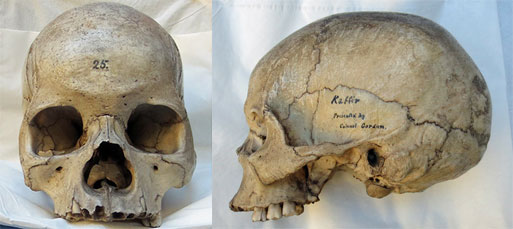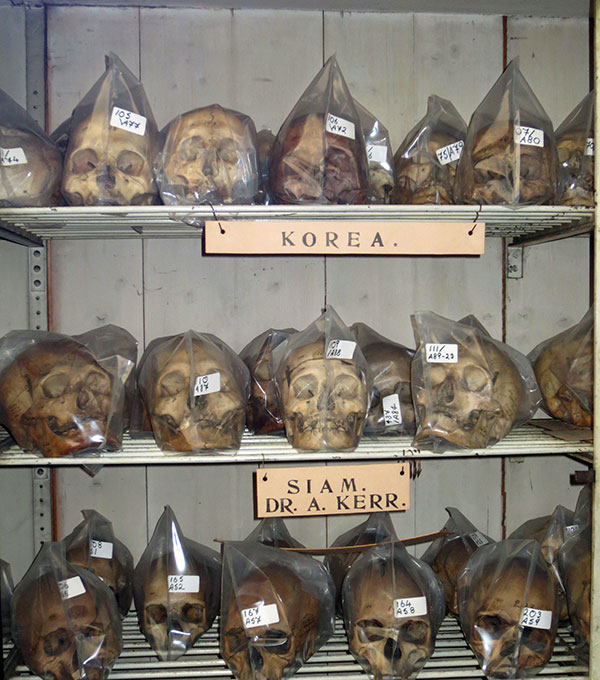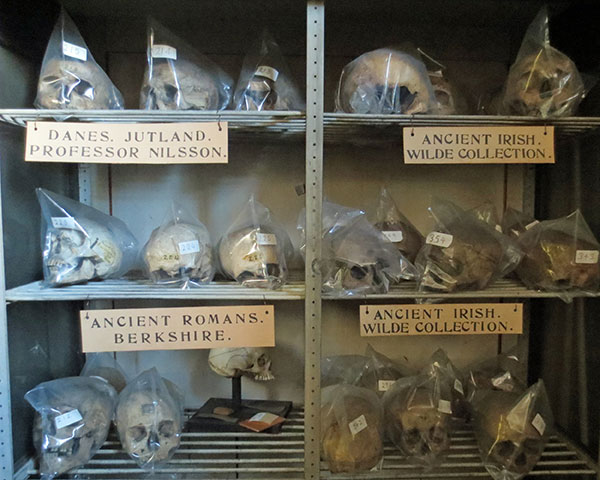A head for science
Published in Features, Issue 2 (March/April 2017), Volume 25The craniology collection in Trinity College, Dublin
By Miguel DeArce and René Gapert
The journal Nature recently published a colour map of the human brain (opposite page), identifying 100 brain regions with their distinctive functions. This brought to our mind other, older, nineteenth-century ‘phrenological heads’ that can be sourced from antiquarians throughout Europe (opposite page). Such bald heads also have areas delimited on the scalp, with functions assigned to the brain region immediately beneath them. Needless to say, the methods used in the making of both maps are immensely different, and so are their value and accuracy. We have not attempted to compare both images with regard to their alleged functional maps; that is not the point. The point is that within the space of two centuries, and mostly in the last decades, the brain has been the focus of intense attention.
Phrenology was popular in nineteenth-century Ireland among members of the Kirwanian Society and the Unitarian Society, both of which converged in Joseph Priestley (1733–1804), an English natural philosopher with an interest in the chemistry of gases who discovered the nature of nine gaseous substances, including oxygen. Priestly had taught chemistry and unitarianism (a variant form of deism that did away with the Trinity) to Richard Kirwan (1733–1912), a wealthy Galwayman and early scientist, and other Irish figures, who then organised the Phrenological Society. With its own journal and premises in Sackville Street, Dublin, it set itself in opposition to the scientific élites of the Royal Dublin Society and the Royal Irish Academy, where it was not well received, although in both royal institutions, as well as in Trinity College (where several phrenological heads can be found in the Museum of Anatomy), there were members sympathetic to it. At its core phrenology was materialistic, squeezing out the knowing person in favour of simply the brain.
Embarrassingly large collections of skulls
The skull is a very tough structure that can survive intact for many decades or even centuries after death, while the other parts of the body are dispersed or disappear. It is also compact and easily transported, and an object of strange beauty, smiling with an enigmatic stare, around which the thoughts of our mortality—and, at the same time, of our immortality—spontaneously gather. It is not surprising, then, that skulls came to be considered a natural collectable in the aestheticism of the Victorian culture surrounding death, especially when science could provide a sheltered space of quasi-religious contemplation and respectability.
Craniology left academic institutions in Europe and America littered with now embarrassingly large collections of skulls. The Royal College of Surgeons in London kept more than 3,000 skulls, and Le Musée de l’Homme in Paris had 15,000, gathered by Armand de Quatrefages (1810–92). In Ireland the largest such collection, some 500 items, was held in the Museum of Anatomy in Trinity College, and many scholars had contributed to building it up. One of us (Miguel) came across this collection while reading a paper by William King, published in 1864, defining Homo neanderthalensis as the only other species of Homo besides us sapiens. King said there that ‘I became acquainted with the skulls from the main races of man’, specifying the Museum in Trinity College Dublin and saying later that he visited it personally, mentioning specifically a ‘Kaffir skull’ from South Africa and one from the Andeman Islands in the Bay of Bengal. When we visited the Museum ourselves, with the expert assistance of Mrs Siobhán Ward we were able to find these two skulls within minutes, exactly as stated by King about 150 years ago. Many other items that King mentioned are still there, such as ancient skulls from Belgium and Denmark, Australia and other places. His visit to the Museum of Anatomy must have occurred in the summer of 1862, the date that he also mentioned for his excursion to the beautiful ruins of Corcomroe Abbey in the Burren, Co. Clare. Here he found a burial place with many skulls, of which he took one for closer study; having been found in a Catholic graveyard, he estimated it at 500 years old or more.

Above: The ‘Kaffir skull’ (front and side) from South Africa referred to in an 1864 paper by William King—still on the shelves of the Museum of Anatomy, Trinity College, Dublin.
With regard to King’s interest in craniology, it is unusual that, just after having ‘scored’ what we today consider a success with his Neanderthal paper in 1864 (the name persists 150 years after the event), he never revisited the subject, although it remained very current. This was probably due to the fact that his presentation did not appear to have been so successful on the day. Few people attended, and they were geologists, not anthropologists. In addition, in December 1863 John Cleland, who, unlike King, was a professional human anatomist, was appointed to the corresponding chair in Queen’s College Galway, thus cutting the anatomical ground from under King’s geological feet. All these circumstances made a rather sharp point: that in writing on Neanderthal as he had done, King was outside his academic competence.
While the figure of 500 skulls is modest compared to the numbers held in other institutions, those few hundred found in Trinity comprise items from the five continents and are ancient and modern. Among the oldest are an Egyptian from the second dynasty and an ancient Roman said to be 5,000 years old. Aside from the Irish, of which there are several dozen (and many casts), the number of skulls in the collection having the same provenance is small, sometimes just two or three. Probably the purpose of the collection was not to teach pathology—although a few of the skulls are catalogued as pathological—but to illustrate the normal variations of the skull within, but mostly between, the different races or isolated human groups. In the nineteenth century such comparisons could not be carried out in the modern scientific way because the requisite statistical method was not developed until the 1930s and later. Scientists compared literal descriptions, visual impressions from drawings or individual measurements, which were not very meaningful.
‘Gifts’ from military campaigns
From the catalogue of the collection, put together by Prof. J. Cunningham (tenure 1870–93), we know that many of the skulls in Trinity were ‘gifts’ from officers who took part in military campaigns in Africa against native tribes. Such a practice of taking the dead enemy’s head from the battlefield and sending it back to the rear for study was naturally unknown to the natives, who were surprised by it. It was also frequent in the Indian Wars in North America, where US army surgeons on the field of battle supervised the collecting and preserving. The Trinity collection shows that similar practices continued during the Great War in Europe, although most of the skulls there are from non-Europeans and from the nineteenth century or earlier. Other skulls were obtained, often illegitimately, from burial places by some explorers or missionaries, who then donated them for study on their return home. Such was the case of Arthur Kerr (1877–1943), a native of Kinlough, Co. Leitrim, who obtained degrees in Botany and Medicine from Trinity (1901) and explored Siam in his double capacities as botanical collector and officer of the health service in the north of that country. He came back to Dublin on furlough in 1908, and the skulls gathered under his name in the Museum were very likely donated at that time. Another donor who features in the Museum below the crania from Jutland (Denmark) was Professor Nilsson. Without documentary proof of his identity, we consider that this was Sven Nilsson (1787–1883), professor in the University of Lund (Sweden) and innovative archaeologist, who in 1838–43 was arguing that, ‘in the greyest antiquity, ancestors of the Lapps inhabited Britain, Ireland, Scandinavia, northern Germany and part of France’. William Wilde (1815–76), another donor of (mostly ancient Irish) skulls to the Museum, proposed in 1849 an ‘ethnic affinity’ between Lapps or Finns in the north and the Iberian or Basque ‘aborigines’ of the south and west. Some of the skulls from the colonies often belonged to people who were illustrious in their communities, who were consequently offended by the desecration. That was famously the case also for the 50 Basque skulls that Paul Broca stole from the cemetery in Lequeitio (Vizcaya, Spain), as he himself narrated. The Maoris from New Zealand and the Australian Aborigines—in whose religions the dead play a very active role—have set up through their respective governments, or privately, schemes that have resulted in the repatriation of many of these remains and in which the National Museum of Ireland, Trinity College and the Royal College of Surgeons in Ireland, as well as many other institutions worldwide, have participated.

41 Above: Part of the collection of Arthur Kerr (1877–1943), a native of Kinlough, Co. Leitrim, who explored Siam (Thailand) in the early twentieth century. Some may have been obtained illegitimately, from burial places. (Museum of Anatomy, TCD)
Celtic skulls sought after
The largest number of skulls (and casts) in the Museum are Irish, although there are probably more Irish skulls in other European institutions than in Trinity. The Celtic model of skull was highly sought after in Victorian times. The Irish, particularly those from the west and from the islands, being on the fringes of Europe, were thought to have been isolated for a long time, thus representing the ‘pure’ Irish. The relatively small numbers of skulls found in the Museum, in spite of the intense anthropological studies of the local populations around the 1890s, could be explained by the fact that at the turn of the century, when Professors Haddon and Browne operated their famous anthropological mission to the west of Ireland, they collected and studied not only skulls but also head measurements from living individuals, who could attest to their immediate origin. These, as well as the study of isonimy (the recurrence of the same family names in a given area) and some of the data collected by the 1950s Harvard mission to the Aran Islands, were only studied with contemporary statistical sophistication in the 1980s. These studies confirmed that in some of the islands, together with descendants from ancient natives, there was a considerable inflow of English genetic influence owing to the garrisoning of those islands with some hundreds of English soldiers since the seventeenth century. Other Irish skulls or casts in the Museum are ancient, some even pre-Christian, while others belong to recent Irish celebrities. Famously among these, there are records in the catalogue of casts of the skulls of Jonathan Swift and his friend Stella, as well as of Daniel O’Connell’s skull, but no trace has been found of them in recent inspections. This suggests, perhaps, that one of the unstated purposes of the collection was nation-building, to provide a subtle form of evidence against the invading power that the Irish were an ancient race with their own identity and achievements.

Above: Part of the Nilsson and Wilde collections. Professor Sven Nilsson (1787–1883) of the University of Lund, Sweden, argued that ‘in the greyest antiquity, ancestors of the Lapps inhabited Britain, Ireland, Scandinavia, northern Germany and part of France’. William Wilde (1815–76), a donor of mostly ancient Irish skulls, proposed in 1849 an ‘ethnic affinity’ between Lapps or Finns in the north and the Iberian or Basque ‘aborigines’ of the south and west. (Museum of Anatomy, TCD)
As is often the case with collections, this one of crania in the Museum does not appear to have grown with any single research purpose in mind and did not increase much after the First World War, falling into gradual disuse as anthropology focused on other, less cumbersome resources. Currently the Museum is in the process of change, gathering together obsolete teaching materials, old publications, animal and palaeontological casts and ancient laboratory equipment, reflecting an older chapter in the history of science which cannot be judged by our current standards of either science or ethics. The collection as it stands today reflects the effort that went into the care of the skulls, which are kept individually wrapped in clear polythene bags and bearing a number that refers to the entry in the manuscript catalogue put together in the early 1900s by Professor Cunningham, although the catalogue itself is often not very informative. A subcommittee of the staff of the department, chaired by Professor Martina Hennesy, is supervising the recovery and evaluation of this mass of teaching material received from an old and very different academic community.
Miguel DeArce lectures in the Department of Genetics, Trinity College, Dublin; René Gapert works for Human Remains Services Ireland; both are writing on behalf of the Steering Committee for the Museum of Anatomy, Trinity College, Dublin.
Read More:
Phrenology
Craniology
FURTHER READING
W. King, ‘The reputed fossil man of the Neanderthal’, Quarterly Journal of Science 1 (1864), 88–96.
E. Leaney, ‘Phrenology in XIX century Ireland’, New Hibernian Review 10 (3), (2006), 24–42.
















